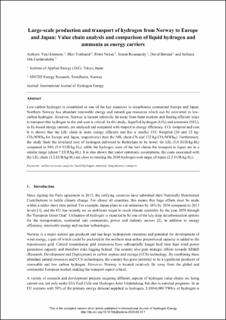| dc.contributor.author | Ishimoto, Yuki | |
| dc.contributor.author | Voldsund, Mari | |
| dc.contributor.author | Nekså, Petter | |
| dc.contributor.author | Roussanaly, Simon | |
| dc.contributor.author | Berstad, David Olsson | |
| dc.contributor.author | Gardarsdottir, Stefania Osk | |
| dc.date.accessioned | 2021-07-14T09:02:36Z | |
| dc.date.available | 2021-07-14T09:02:36Z | |
| dc.date.created | 2020-10-19T14:47:19Z | |
| dc.date.issued | 2020 | |
| dc.identifier.issn | 0360-3199 | |
| dc.identifier.uri | https://hdl.handle.net/11250/2764352 | |
| dc.description.abstract | Low-carbon hydrogen is considered as one of the key measures to decarbonise continental Europe and Japan. Northern Norway has abundant renewable energy and natural gas resources which can be converted to low-carbon hydrogen. However, Norway is located relatively far away from these markets and finding efficient ways to transport this hydrogen to the end-user is critical. In this study, liquefied hydrogen (LH2) and ammonia (NH3), as H2-based energy carriers, are analysed and compared with respect to energy efficiency, CO2 footprint and cost. It is shown that the LH2 chain is more energy efficient and has a smaller CO2 footprint (20 and 23 kg-CO2/MWhth for Europe and Japan, respectively) than the NH3 chain (76 and 122 kg-CO2/MWhth). Furthermore, the study finds the levelized cost of hydrogen delivered to Rotterdam to be lower for LH2 (5.0 EUR/kg-H2) compared to NH3 (5.9 EUR/kg-H2), while the hydrogen costs of the two chains for transport to Japan are in a similar range (about 7 EUR/kg-H2). It is also shown that under optimistic assumptions, the costs associated with the LH2 chain (3.2 EUR/kg-H2) are close to meeting the 2030 hydrogen cost target of Japan (2.5 EUR/kg-H2). Keywords Techno-economic analysisLiquid hydrogenAmmoniaLong distance transport | en_US |
| dc.language.iso | eng | en_US |
| dc.publisher | Elsevier | en_US |
| dc.rights | Attribution-NonCommercial-NoDerivatives 4.0 Internasjonal | * |
| dc.rights.uri | http://creativecommons.org/licenses/by-nc-nd/4.0/deed.no | * |
| dc.title | Large-scale production and transport of hydrogen from Norway to Europe and Japan: Value chain analysis and comparison of liquid hydrogen and ammonia as energy carriers | en_US |
| dc.type | Peer reviewed | en_US |
| dc.type | Journal article | en_US |
| dc.description.version | acceptedVersion | en_US |
| dc.source.pagenumber | 32865-32883 | en_US |
| dc.source.volume | 45 | en_US |
| dc.source.journal | International Journal of Hydrogen Energy | en_US |
| dc.source.issue | 58 | en_US |
| dc.identifier.doi | 10.1016/j.ijhydene.2020.09.017 | |
| dc.identifier.cristin | 1840573 | |
| dc.relation.project | Norges forskningsråd: 255107 | en_US |
| cristin.ispublished | true | |
| cristin.fulltext | postprint | |
| cristin.qualitycode | 1 | |

